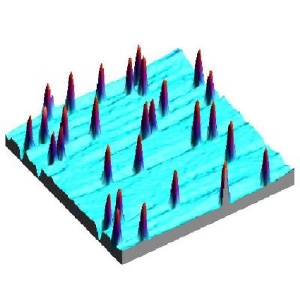Feb 5 2009
Scientists at the Naval Research Laboratory (NRL) have recently demonstrated the ability to control the spin population of the individual quantum shell states of self-assembled indium arsenide (InAs) quantum dots (QDs). These results are significant in the understanding of QD behavior and scientists' ability to utilize QDs in active devices or for information processing.
 This is an atomic force microscope image of the uncovered QDs. Credit: Naval Research Laboratory
This is an atomic force microscope image of the uncovered QDs. Credit: Naval Research Laboratory
The scientists, from NRL's Materials Science and Technology Division, used a spin-polarized bias current from an iron (Fe) thin film contact and determined the strength of the interaction between spin-polarized electrons in the s, p and d shells. A complete description of this work can be found in Physical Review Letters (28 November 2008).
Semiconductor QDs are nanoscale circular disks of one semiconducting material, typically 3 nm high by 30 nm in diameter, embedded within layers of a second material. Figure 1 shows such a structure, with an atomic force microscope image of the uncovered QDs in figure 2. Semiconductor QDs are attractive for a variety of quantum information processing, electronic and spintronic applications. In spintronic applications, the electron's spin rather than charge is used to store and process information. The International Technology Roadmap for Semiconductors has identified the electron's spin as a new state variable which should be explored as an alternative to the electron's charge for use beyond standard CMOS technology. The QD electronic structure exhibits the s,p,d,f shells characteristic of single atoms, so they are often referred to as "artificial atoms."
The NRL researchers monitor the shell population and spin polarization by measuring the polarized light emitted as a function of the bias current from the Fe contact. In contrast with previous work, they resolve features in the electroluminescence (EL) spectra associated with the individual quantum levels (s-, p-, d-, and f- shells). As the bias current is increased, the shell states fill, and the EL from the QDs exhibits peaks characteristic of the shell energies, as labeled in figure 3.
Intershell exchange strongly modifies the optical polarization observed from that expected for simple models of shell occupation. From a detailed analysis of the EL spectra, the NRL researchers were able to obtain the first experimental measure of the exchange energies between electrons in the s- and p-shells, and between electrons in the p- and d-shells. These energies describe the degree of interaction between these quantum levels.